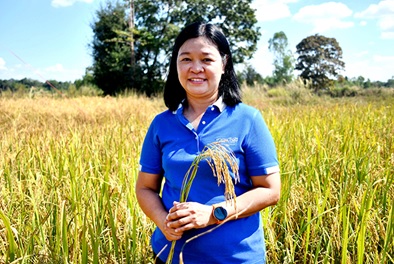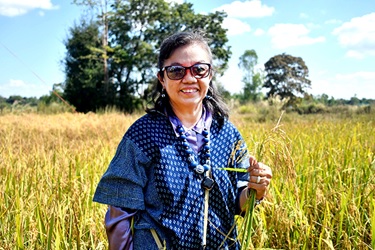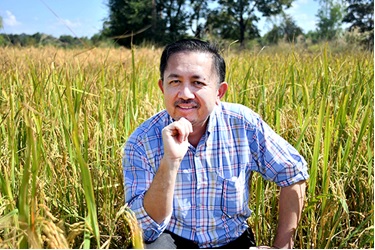Medium height, high yield, disease resistance and easy to harvest are among key features of Hom Siam rice, a new rice variety developed by BIOTEC-NSTDA in collaboration with Kasetsart University and partner organizations. While Hom Siam has excellent cooking qualities - softness, fragrance and flavor - comparable the famous Thai jasmine rice, it has an advantage over the jasmine rice in terms of disease resistance and drought tolerance, making it acceptable to both farmers and consumers.

A decade of R&D
Dr. Jonaliza L. Siangliw, BIOTEC researcher who led the development of Hom Siam revealed that it took the team ten years to achieve the fragrant rice variety with these amazing traits, including drought tolerance, blast resistance, high yield and superb cooking quality on par with the jasmine rice KDML 105. Hom Siam is a cross between drought-tolerant “RGD03068-2-9-1-B (RGD03068)” variety and blast-resistant, short-stem "Kaew Kaset" variety. Marker-assisted technique was employed in the breeding.

Jonaliza further explained three outstanding features of Hom Siam. Firstly, the variety was developed to achieve a medium height of 105 cm. KDML 105’s tall stature of 150 cm makes it susceptible to lodging causing low yield. The medium height allows Hom Siam to thrive better, contributing to its higher yield. Secondly, Hom Siam was designed to resist blast, the disease which threatens the production of both KDML 105 and RD 15. Thirdly, Hom Siam provides twice as much yield than KDML 105 due to higher number of shoots per bunch and greater number of grains per ear. In addition, its deep root system enables it to survive under drought condition.
Farmers and consumers adoption

In 2020, the field trials of Hom Siam took place in three provinces, namely Ubon Ratchathani, Amnat Charoen and Sisaket. Participating in the trials were rice growers in the network of Bangsue Chia Meng Rice Mill. The results showed an average yield of 530 kg per rai (3.31 tons per ha) at 14% moisture content. The yield is 2.1 times higher than that of jasmine rice KDML 105 planted in the same area. The field trials in 2021 were expanded to upper northern and northeastern Thailand, encompassing 12 provinces. A total of 31 farmers joined the project, covering a total planting area of 21 rai (3.36 ha).

Dr. Kanyanat Sirithunya, an expert in rice breeding and farmer participatory field trial, stated that farmers were pleased with the advantages the new variety offers over KDML 105, including high yield, semi-dwarf stature, sturdy stem, and resistance to blast and neck blast. Disease resistance enables farmers to use less pesticide, whereas the medium height prevents the production loss due to lodging and makes it easy to harvest.
Kanyanat explained that as a rice breeder, success comes when the variety is accepted by farmers, rice mills and traders. Over the past two years of field trials, Hom Siam has demonstrated its potential to farmers and rice mills in 12 provinces. Once farmers and industry are satisfied with the variety, it has a good chance to enter the market.
A promising variety for Thailand
Thailand is a world-renowned producer of quality rice. Thai jasmine rice, in particular, was named the world's best rice multiple times. However, rice production in Thailand has been threatened by extreme weather and rising production cost.

Breeding rice varieties that are climate resilient, high yielding and provides good cooking quality is the solution to this crisis, said BIOTEC Deputy Executive Director Dr. Theerayut Toojinda, and Hom Siam exemplifies this approach. It has desirable cooking quality of jasmine rice, but provides far better yield, resists to blast disease, thrives better with shorter stature, and survives better under drought condition due to a deep root system. The medium height also makes it easier to be harvested by machine, suitable for modern farming. Application for a variety registration of Hom Siam has already been filed with the Department of Agriculture.
Hom Siam represents a promising rice variety with both good cooking quality and high yield, enabling Thailand to compete in the global rice market, offering benefits to farmers and reducing negative impact to the environment.
